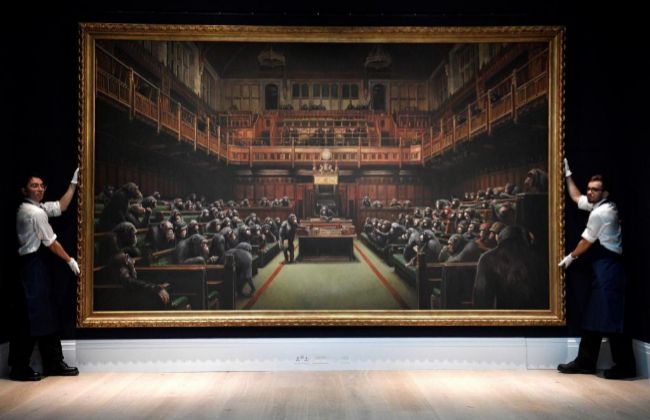Nowadays you have to hit the ground. The politician has to give them and the artist who aspires to be recognized has to give them; They must be given by anyone who intends to capture the elusive attention of the public and poke their heads in the maelstrom of opinions, works of art, books, genius and idiocy produced by the contemporary world. The oceans are full of plastic, yes, and it is a shame, but it is not very different from what happens with contemporary culture : it does not fit a scream, a bullshit, a nonsense, and we still do not have a cleaning team not even with a Greta Thunberg who worries about decontaminating it from stridence and madness.
And it is that such work, although noble, may be more difficult than purging the seas. A cultural Greta would have to deal with true geniuses in the contemporary art of the coup , with real titans in self-promotion strategies at the height of scandals and innocuous rebellions. He would have to measure forces with a Boris Johnson, with a Bolsonaro, with a Trump, but also with the most effective of all, with the true magician in capturing media attention. Our Greta would have to deal with Banksy, the elusive and elusive graffiti artist, who from time to time appears and the whole world cuts her breath, opens her eyes in disbelief and throws a howl of reggaeton in heat - give it all to me, mommy - before huge money figures change hands.
It has happened again a few days ago: Devolved Parliament , one of his paintings, was auctioned by the Sotheby's house for more than 11 million euros. And I say that it happened again because exactly one year ago, in October 2018, the graffiti artist made the most of his advertising performances : the partial self-destruction of one of his paintings just at the time it was sold for more than one million euros . He also did it at Sotheby's, a very unruly place, rather associated with the convention and money , which has established a lucrative working relationship with the transgressive artists of the moment .
This, in today's world, should not be surprising at all. Money and sedition have long gone hand in hand, and the sociological reason should already be obvious to everyone. The rebellion of the artistic avant-garde of the early twentieth century, with its aesthetic and moral challenges, triumphed, enchanted us, seduced us, and now we consume it to feel rebellious without needing to be. A good deal, a good investment, perhaps. And nothing more rebellious, at least as a cliché, than the anonymous graffiti artist who nocturnally "fatigue" the streets until he finds a wall where to express his iconoclastic message. As a stereotype it is perfect; as a reality, rather disappointing. Because today he competes with a much more transgressive and antisocial character, the art merchant, who replicates the cunning of Banksy but not to leave critical messages, but to steal the walls that the graffiti artist has decorated. The police are barely able to protect Banksy from the true offenders, of those punks who are scary even if they wear a suit and receive appetizing checks with six zeros.
It was precisely this attack of capitalism on Banksy's work, on his brand, that encouraged the graffiti artist to open a store in London for a few weeks. Selling his pieces - sculptures ?, souvenirs of a populist and dystopian England ?, youth paraphernalia ?, baubles of a cool Ale-Hop? - he said, prevented any opportunist from appropriating them and taking economic benefit. And of course he has the right to protect his works and prevent someone else from getting rich with them, nor was he lacking. But, in the case of Banksy, we cannot stay on the surface. It should be noted that the opening of Gross Domestic Product coincided with the auction of his painting at Sotheby's; you have to think about that magnificent advertising strategy, that of not letting anyone in and forcing the curious to swirl in the window; it must be assumed that his works are a mere pretext for setting up a media show that is, in the long run, the one that has real effects on reality. Not in the social reality that Banksy criticizes, but in the reality of the art market: their prices soar.
That was not the only advertising strategy the graffiti artist used to promote his store. He also used another, infallible, no longer rebellious but quite the opposite, politically correct. He said he would use the benefits of his shop to save migrants drowning in the Mediterranean. Insuperable! The bad boy becomes good. The wrong one adds to the spirit of the times, the rising values and the art on climate change, minority identities and the suffering of migrants who win awards in biennials. Art of the victims, a new indigenismo to the European. In the case of Banksy, seismograph of the values that succeed and sell, it could not be otherwise. Goodbye to rebellion and impropriety, that remain Johnson, Bolsonaro, Trump and the extreme right . Welcome the noble causes. Welcome a new niche market.
According to the criteria of The Trust Project
Know more- culture
- Art
- London
ArtThe 30 million Botticelli de los Cambó
ArteNumerous offers for the Botticelli protected in London: marketing begins
The Sphere of Paper Insumisas: voices for feminist rebellion

